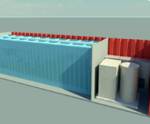A US company states it has developed a self-healing rechargeable zinc-air battery system capable of 10,000 cycles – a 30 year working life. With applications including utility-scale energy storage; the argument regarding wind and solar power’s intermittency will continue to weaken if the technology delivers.
Created by Eos Energy Storage, the Aurora zinc-air battery is based on similar chemistry used in alkaline batteries that contain zinc and manganese dioxide; but in the Aurora, the manganese dioxide has been replaced with a “thin air electrode”. Oxygen from ambient air is utilized as a cathode reactant the company says, saving space and cost.
Eos states the technology and components used in the Aurora are safe, stable and recyclable. Zinc is also a plentiful metal and Australia is one of the world’s top zinc producers.
The concept of a zinc-air battery isn’t new, they are already in use as non-rechargeable batteries for appliances such as hearing aids and watches. However, many challenges have prevented the technology from being used in deep cycle energy storage applications. One of the issues has been electrolyte drying out over time as oxygen enters the battery. Eos says it has developed an electrolyte management and self-filling/healing system operation to address the issue.
Testing to date by the company has seen the Aurora rechargeable zinc-air battery cycled over 2,000 times with no physical degradation observed.
Eos Energy Storage says it is currently scaling up prototypes of its Eos Aurora 1000 | 6000 Battery for initial manufacturing this year and delivery of megawatt scale systems in 2013. The Eos Aurora will initially cost $1000/kW/$160/kWh. For renewable energy integration and load shifting applications, Eos says the levelized energy cost will be among the lowest; comparable to pumped hydro and combined cycle gas turbines.
Eos is also developing a zinc-air flow battery for use in electric vehicles, which combined with a lead acid battery system also created by the company will extend EV range to over 500 kilometres and can be recharged for less than 2 cents per kilometre.
Other emerging battery and energy storage technologies we’ve reported on previously; some of which are already now in use in real-world applications:
– Iron phosphate
– Lithium-air
– Virus
– Cavern
– Molten salt
– Beltway
– Flywheel
– Iron based flow
– Vanadium based flow
– Liquid metal
– Silicon air












































